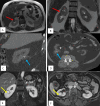Ethical dilemmas surrounding patients´ "unwise" treatment preferences and suboptimal decision quality: case series of three renal cell carcinoma patients who developed local recurrences after non-guideline-concordant care choices
- PMID: 39867546
- PMCID: PMC11760209
- DOI: 10.11604/pamj.2024.49.45.42047
Ethical dilemmas surrounding patients´ "unwise" treatment preferences and suboptimal decision quality: case series of three renal cell carcinoma patients who developed local recurrences after non-guideline-concordant care choices
Abstract
Patient engagement and shared decision-making (SDM) between patients and clinicians is the foundation of patient-centered care. It aims to reach a treatment option that fits the patient's preference and is guideline-concordant. We sought to evaluate the possible causes and outcomes of patient's non-guideline-concordant care choices. Using a retrospective analysis of the medical records of patients who underwent cryoablation for small renal masses between January 2010 and January 2023. Inclusion criteria were patients with renal tumor(s) who underwent cryoablation which was not recommended by the multidisciplinary team (MDT). We present three patients with unilateral clear cell renal cell carcinoma. Based on imaging and other findings, the oncology MDT recommended partial/radical nephrectomy. Upon consultation, each refused surgery and preferred cryoablation. Respecting their choice, cryoablation was undertaken. The patients had treatment failure and developed recurrences that could have possibly been avoided with guideline-concordant care. Shared decision-making in healthcare involves several aspects: patient/family; uncertainty of available evidence of various treatments; MDT meetings; and treatment team. For patients to select 'wise' treatment preferences i.e. guideline-concordant care, multi-layered complex intellectual and cognitive processes are required, where experience may play a role. Healthcare professionals require guidance and training on appropriate SDM in clinical settings, and awareness of tools to solicit patient choice to guideline-concordant care whilst observing patient autonomy. Patients and treatment teams need the capacity, knowledge, and skills to reach a 'wise' guideline-concordant care treatment preference jointly. Patients' unwise preference could lead to suboptimal outcomes, in the case of our patients, tumor recurrence.
Keywords: Cryoablation; guideline-concordant therapy; partial nephrectomy; patient-centered medicine; renal cell carcinoma; shared decision-making.
Copyright: Khalid Al Rumaihi et al.
Conflict of interest statement
The authors declare no competing interests.
Figures


Similar articles
-
Can We Enhance Shared Decision-making for Periacetabular Osteotomy Surgery? A Qualitative Study of Patient Experiences.Clin Orthop Relat Res. 2025 Jan 1;483(1):120-136. doi: 10.1097/CORR.0000000000003198. Epub 2024 Jul 23. Clin Orthop Relat Res. 2025. PMID: 39051876
-
Shared decision-making for people with asthma.Cochrane Database Syst Rev. 2017 Oct 3;10(10):CD012330. doi: 10.1002/14651858.CD012330.pub2. Cochrane Database Syst Rev. 2017. PMID: 28972652 Free PMC article.
-
Cryoablation vs radiofrequency ablation for the treatment of renal cell carcinoma: a meta-analysis of case series studies.BJU Int. 2012 Aug;110(4):510-6. doi: 10.1111/j.1464-410X.2011.10885.x. Epub 2012 Feb 3. BJU Int. 2012. PMID: 22304329
-
Falls prevention interventions for community-dwelling older adults: systematic review and meta-analysis of benefits, harms, and patient values and preferences.Syst Rev. 2024 Nov 26;13(1):289. doi: 10.1186/s13643-024-02681-3. Syst Rev. 2024. PMID: 39593159 Free PMC article.
-
Examining How Technology Supports Shared Decision-Making in Oncology Consultations: Qualitative Thematic Analysis.JMIR Cancer. 2025 Jun 11;11:e70827. doi: 10.2196/70827. JMIR Cancer. 2025. PMID: 40499161 Free PMC article.
Cited by
-
Multidisciplinary Surgical Management of Renal Cell Carcinoma With Inferior Vena Cava Tumor Thrombus: Perioperative and Oncological Outcomes.Cureus. 2025 Jun 7;17(6):e85527. doi: 10.7759/cureus.85527. eCollection 2025 Jun. Cureus. 2025. PMID: 40630333 Free PMC article.
References
-
- Malloy-Weir LJ, Schwartz L, Yost J, McKibbon KA. Empirical relationships between numeracy and treatment decision making: A scoping review of the literature. Patient Educ Couns. 2016 Mar 1;99(3):310–25. - PubMed
-
- DiMatteo MR, Giordani PJ, Lepper HS, Croghan TW. Patient adherence and medical treatment outcomes: a meta-analysis. Med Care. 2002 Sep 1;40(9):794–811. - PubMed
-
- Peters LJ, Stubenrouch FE, Thijs JB, Klemm PL, Balm R, Ubbink DT. Predictors of the Level of Shared Decision Making in Vascular Surgery: A Cross Sectional Study. Eur J Vasc Endovasc Surg. 2022 Jul 1;64(1):65–72. - PubMed
Publication types
MeSH terms
LinkOut - more resources
Full Text Sources
Medical
